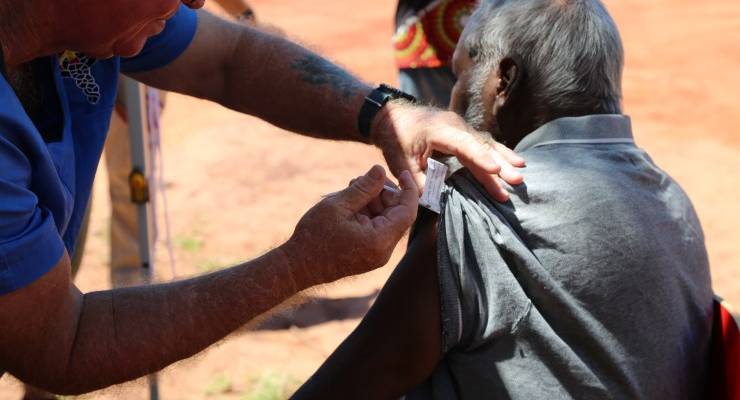
There are huge concerns for Australia’s Indigenous population as Queensland reopened its borders at 1am and Western Australia expected to announce when it will reopen later today.
Aboriginal and Torres Strait Islander populations in regional areas have vaccination rates as low as 38%. Targeted communication campaigns arrived too late and a distrust of politicians fuelled hesitancy.
Although the Commonwealth has targeted 30 Aboriginal communities bringing about a surge in vaccinations, much of this is too little, too late with poor messaging and staff shortages leaving vaccination gaps across the country.
Where’s the lowest uptake?

Indigenous vaccination rates vary by state and region, but those in rural areas are less likely to have had two doses. The Australian Capital Territory has the highest rate of fully vaccinated Indigenous Australians over 15 — at 86% — although it also has the smallest population of Aboriginal and Torres Strait Islander Australians at 1.9%.
Outback Western Australia has the lowest uptake at just 38%, although it doesn’t get much better in Perth with Indigenous vaccination rates there at just 45%. It’s a similar story in Queensland, where just 44% of the population is vaccinated in Cairns, and 46% in central Queensland and Townsville.
NSW and Tasmania fare better: areas with the lowest uptake still top nearly 70%, while in Victoria, Gippsland has the lowest rate at almost 80%.
The government only recently started releasing vaccination data for First Nations people after public calls in August, despite Indigenous Australians being prioritised in the first stage of the rollout.
Why is this such a concern?
Aboriginal and Torres Strait Islander people have a life expectancy nine years shorter than non-Aboriginal Australians, and 60% of deaths are caused by potentially avoidable illnesses. Much of this is caused by limited access to health services in regional areas, generational trauma, displacement, substance abuse and lower levels of education.
Aboriginal communities where there are high comorbidities, crowded housing and poorer general health are particularly susceptible to outbreaks and severe cases of COVID. The vaccine rollout was off to a slow start in many regional areas, with northern WA’s medical services facing severe staff shortages in the middle of the year — which was slow to be fixed by the government.
It’s a massive concern as case numbers across the country surge: Christmas travel, eased social restrictions and a focus on “living with COVID” has seen high rates of transmission, with NSW recording 536 new COVID cases this morning, the highest number since early October. Victoria has consistently recorded more than a thousand new daily cases for months.
Why the delay?
Wiradjuri man and chair of RACGP Aboriginal and Torres Strait Islander Health Professor Peter O’Mara tells Crikey addressing hesitancy was too little and too late.
“In general, we need to be getting out there and stopping the communications that aren’t helpful or aren’t based on any science or truth,” he said.
“I would have liked to have seen in some way people be made more accountable for talking nonsense. Freedom of speech is fine, but there’s a difference between freedom of speech and just talking nonsense that puts people off getting vaccinated.”
He says it was unlikely political anti-vaccination messages such as MP Craig Kelly’s on adverse reactions to the vaccine were making a huge impact on Indigenous populations, but that misinformation fuelled on social media, coupled with the religious rhetoric that God can protect believers from illness, was a major concern.
“Senior Aboriginal religious leaders have spoken out about getting vaccinated which has been quite positive,” O’Mara said, but he added more community-led campaigns were necessary.








There’s something dreadfully ailing in the heart of country that can’t look after it’s own most vulnerable – including the aged, the handicapped and the Indigenous (compounded in their neglected suffering with inclusions of those other demographic) – that sees such welfare as more of a “cost to be efficiently/niggardly managed”. And that ailing heart is this commodifying elected government.
“Don’t worry, Covid won’t kill me. I have faith.”
“Bush medicine will treat it”.
“We’ll take her back to country”. “She died from white man’s medicine”.
“He died in the Covid ward of pneumonia” because of course his family will not accept that the pneumonia was from Covid probably caught while he was addressing an Anti- VAX rally.
Will anyone, please tell me/ us what strategies will work on this, blind acceptance/ denial?
As a child raised as a Catholic, we were taught that to reject medical treatment was to throw God’s work back in his face.
I can not bring myself to say this to people not being vaccinated.
10 to a room, COPD, diabetic, half deaf, semi-blind, 5 languages with English the one least used, 4 vaccinated, 300km to the nearest nurse, 500 to the nearest hospital. What could possibly go wrong? Crap vehicles, dirt road, a culture in which everyone has to go to every funeral within 1000km, a virus which now transmits faster than a formula 1 racecar. There are hundreds of remote, back to country little townships which are looking down the barrel. There is no possibility of sufficient health care resources coming to the rescue. So it’s not looking good. I doubt there’s even a plan.
Having had two years to prepare.
Compare the Covid vax campaign and the AIDS education and awareness campaign targeting Indigenous people. Community led, Govt support and high priority for everyone. Very few AIDS deaths. The template is there.
Maybe Crikey could show us some examples how other nations have done it well Is this problem being repeated with all indigenous peoples, or is it something unique to Australia? Is there something we can learn from those other countries?
The way things are shaping up it looks like the best protection for Aboriginal communities (and other vulnerable groups) would be to expose them to the omicron variant and give them a box of tissues,